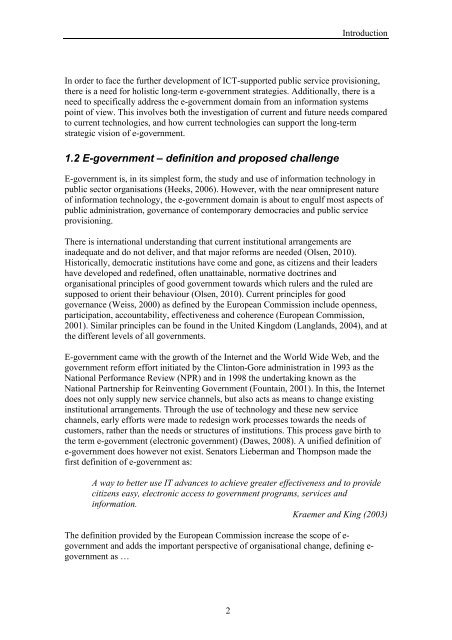Multi-channel provisioning of public services - Department of ...
Multi-channel provisioning of public services - Department of ...
Multi-channel provisioning of public services - Department of ...
You also want an ePaper? Increase the reach of your titles
YUMPU automatically turns print PDFs into web optimized ePapers that Google loves.
Introduction<br />
In order to face the further development <strong>of</strong> ICT-supported <strong>public</strong> service <strong>provisioning</strong>,<br />
there is a need for holistic long-term e-government strategies. Additionally, there is a<br />
need to specifically address the e-government domain from an information systems<br />
point <strong>of</strong> view. This involves both the investigation <strong>of</strong> current and future needs compared<br />
to current technologies, and how current technologies can support the long-term<br />
strategic vision <strong>of</strong> e-government.<br />
1.2 E-government – definition and proposed challenge<br />
E-government is, in its simplest form, the study and use <strong>of</strong> information technology in<br />
<strong>public</strong> sector organisations (Heeks, 2006). However, with the near omnipresent nature<br />
<strong>of</strong> information technology, the e-government domain is about to engulf most aspects <strong>of</strong><br />
<strong>public</strong> administration, governance <strong>of</strong> contemporary democracies and <strong>public</strong> service<br />
<strong>provisioning</strong>.<br />
There is international understanding that current institutional arrangements are<br />
inadequate and do not deliver, and that major reforms are needed (Olsen, 2010).<br />
Historically, democratic institutions have come and gone, as citizens and their leaders<br />
have developed and redefined, <strong>of</strong>ten unattainable, normative doctrines and<br />
organisational principles <strong>of</strong> good government towards which rulers and the ruled are<br />
supposed to orient their behaviour (Olsen, 2010). Current principles for good<br />
governance (Weiss, 2000) as defined by the European Commission include openness,<br />
participation, accountability, effectiveness and coherence (European Commission,<br />
2001). Similar principles can be found in the United Kingdom (Langlands, 2004), and at<br />
the different levels <strong>of</strong> all governments.<br />
E-government came with the growth <strong>of</strong> the Internet and the World Wide Web, and the<br />
government reform effort initiated by the Clinton-Gore administration in 1993 as the<br />
National Performance Review (NPR) and in 1998 the undertaking known as the<br />
National Partnership for Reinventing Government (Fountain, 2001). In this, the Internet<br />
does not only supply new service <strong>channel</strong>s, but also acts as means to change existing<br />
institutional arrangements. Through the use <strong>of</strong> technology and these new service<br />
<strong>channel</strong>s, early efforts were made to redesign work processes towards the needs <strong>of</strong><br />
customers, rather than the needs or structures <strong>of</strong> institutions. This process gave birth to<br />
the term e-government (electronic government) (Dawes, 2008). A unified definition <strong>of</strong><br />
e-government does however not exist. Senators Lieberman and Thompson made the<br />
first definition <strong>of</strong> e-government as:<br />
A way to better use IT advances to achieve greater effectiveness and to provide<br />
citizens easy, electronic access to government programs, <strong>services</strong> and<br />
information.<br />
Kraemer and King (2003)<br />
The definition provided by the European Commission increase the scope <strong>of</strong> e-<br />
government and adds the important perspective <strong>of</strong> organisational change, defining e-<br />
government as …<br />
2
















